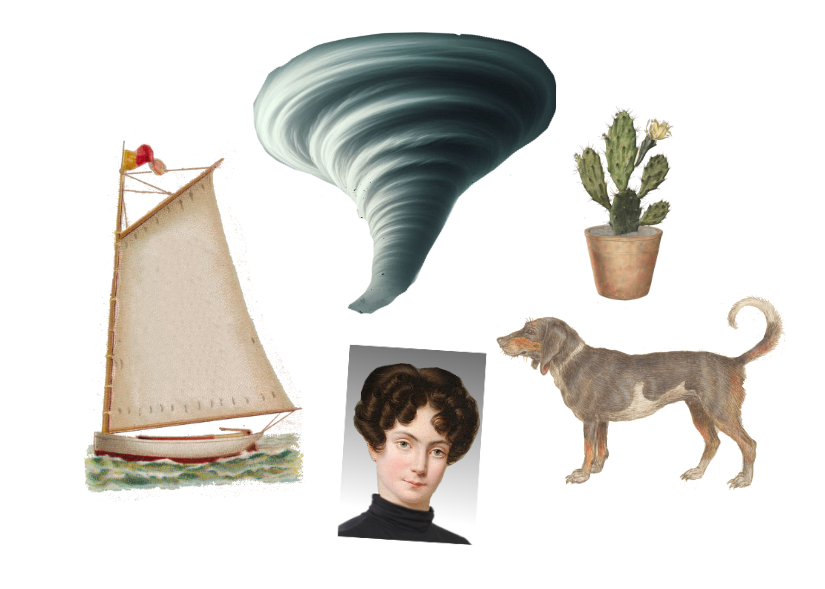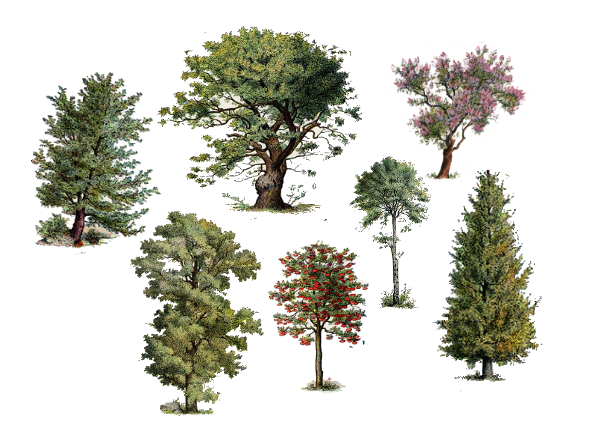Section 6.2 A closer look at reference: extension
Perhaps you have noticed a difference in the way we described sense and reference in the preceding section: sense was described as something that is associated with a linguistic form in a language user’s mind — as one part of the form-meaning pair we call sign. Reference is described as something that language users do with a sign — it is the use of a sign to pick out a particular entity in a particular context. This raises two questions. First, do signs actually “have” reference in the same way that they “have” form and meaning? And second, what is the relationship between reference as a property of the sign and reference as something language users do with a sign?
Subsection Proper nouns and common nouns
To answer these questions, we must distinguish between two kinds of referring expressions — proper nouns (like Zoe) and common nouns (like tree):
We will also discuss whether verbs (like fell) and adjectives (like dead) refer, and if so, how, but for now, let us concentrate on nouns.
Let us begin with proper nouns, which are often treated as the most typical referring expressions by philosophers of language. You can see why this might be so: proper nouns are all reference and no sense, so they should allow us to observe without any distractions the way in which linguistic expressions refer (in fact, as we will see later, this very quality makes proper names very atypical from a linguistic perspective).
Proper nouns are used to talk about individual entities — they can be proper names, like Zoe in (1), Spain or Venus, but also fixed expressions consisting (wholly or partially) of common nouns, like Agent Scully, German Democratic Republic or morning star. In order to determine whether a name like Zoe refers to a particular entity x, we have to check whether the statement “x (for example: this person) is Zoe” is true. But how can we do this?
Some philosophers have suggested that we do so by associating names with descriptions of their referents. For example, the name Zoe might be associated with descriptions like “my best friend” (in Aylin’s mind), “the young woman with green hair who lives in the apartment next to mine” (in the mind of her neighbor), “my youngest daughter” (in the mind of her mother), etc. If Aylin had to decide whether this person is Zoe is true, she would have to check whether the person in question is, indeed, her best friend. However, this cannot really work: such descriptions would have to be updated continually — Aylin and Zoe could have a fight and no longer be best friends, she could move out and no longer live next door from the neighbor, her mother could have another daughter so she would no longer be the youngest. Of course, they could all update their descriptions — but how would they know that they have to do so, unless they have another way of determining that the person in question is, in fact, Zoe. In other words: we may associate such descriptions with proper names, but the descriptions are not what tells us who or what the proper names refer to.
Another suggestion is that names refer to a particular entity because a naming event occurred at some point in the past — for example, Zoe’s parents entered this name on her birth certificate, or she was baptized with this name, or people simply agreed that this should be her name. In order to determine whether a particular person is Zoe, we would have to trace the name back to such an initial naming event. If we do not interpret the idea of an initial naming event too strictly, this suggestion seems to be on the correct path, but we can simplify it a bit: we can say that this person is Zoe is true if people who know her agree that this is her name. In other words, “x is Zoe” is true if “x bears the name Zoe” is true.
That is all there is to it — the members of the category “entities called Zoe” (some of which are shown in Figure 6.2.1) share exactly one property: their name. Beyond this, they have nothing in common — some of them are people, some are pets or even houseplants, some are ships, some are hurricanes, etc. We have to associate the name Zoe directly with our concept of the individual entity in question. This is how proper names “have” reference.

Images of a sailboat, a tornado, a young woman’s head, a potted cactus and a dog
Of course, names are not usually unique. Zoe is a popular name so there are millions of people called Zoe and many speakers are likely to know more than one of them. This raises the interesting question of how speakers determine which Zoe is referred to in any given utterance. The answer is, roughly speaking, that Zoe always refers to the Zoe that is most salient in the current discourse (for example, because she is present, because it is the only Zoe that all language users involved in the communicative situation know, because she has been mentioned earlier, etc.).
Common nouns like tree are very different, and this means that the way they refer is also different. The members of the category “entities called tree” (some of which are shown in Figure 6.2.2 have many things in common that distinguish them from entities that are not in the category — they are all plants (unlike people, boats or hurricanes), they grow for more than one season (unlike corn or peas), they are woody (unlike flowers), they have a single large trunk (unlike shrubs), etc. We do not have to associate the word tree directly with our concepts of the individual trees we know, nor would this be useful, as we can and do use the word tree to refer to any one of infinitely many individual entities in the category of entities that have the properties just mentioned. This set of potential referents of a word is called its extension.

Images of different types of trees, including large and small trees, coniferous and deciduous trees, large and small trees, trees with and without blossoms
So, common nouns do not really “have” reference. They have an extension — a set of potential referents — and they can be used to refer to any one of these entities. In order to determine whether the statement “x is a tree” is true, we do not check whether “x bears the name tree” is true, we check whether “x is a perennial woody plant with a single large trunk” is true.
The definition of extension as the “set of potential referents” of a word is not quite complete yet: recall the word unicorn, which we discussed in Section 2.2. We claimed that this word does not have reference, since there are — as far as anyone knows — no unicorns. This sounds right — there are no entities of which we could truthfully say “x is a unicorn”, therefore, the word unicorn has no extension and cannot be used to refer. However, the absence of unicorns is a fact about one particular world, the world we call “reality”. But human languages are not restricted to talking about reality! We can imagine, and talk about, many possible worlds in which there are entities of which we could truthfully say “x is a unicorn” — Ponyland from the TV series My Little Pony, the unnamed world of Pokémon, Centopia from the TV series Mia and Me, or any world we might privately or collectively conjure up. We call these worlds “fiction” to distinguish them from reality, and that is a very useful distinction to make with respect to our actions. But with respect to language, it is not necessarily a useful distinction. We can use language in the same way when talking about reality or fiction, and in the fictitious worlds just mentioned, there are entities of which it would be true to say x is a unicorn, and other entities of which it would not be true. Thus, we have to amend our definition and say that the extension of a word is the “set of potential referents in a possible world”. Note that “possible” in “possible world” does not mean “possible in terms of what we know about the universe”, but “possible to imagine in a contradiction-free way”. Thus, there could be a world in which we can truthfully say Celestia is a unicorn, but there is no possible world in which we could say Circles are square.
Subsection Verbs and adjectives
So, what about verbs and adjectives (and words of other word classes)? Signs belonging to these word classes do not seem to have an extension in the way we just defined it — they are not used to talk about entities as such, but about properties, states, actions, processes, etc. Nevertheless, they do have an extension: note that properties, states, actions and processes cannot exist without entities — entities with a particular property, entities in a particular state, entities being affected by a particular action or process, entities performing or being used in performing actions, etc.
These entities can be thought of as the extensions of verbs and adjectives. The extension of a verb like fell, for example, is the set of all entities of which it would be true to say “x fells y”. The extension of an adjective like dead would be the set of entities of which it would be true to say “x is dead”.
The crucial question is how we determine the membership in these categories. With the noun tree, we said that we do so by checking whether an entity has the properties required for membership in the category — is it a plant, is it woody, does it have a single trunk, etc. For the verb fell, we would have to check whether two entities are in a relationship that has the properties associated with felling — is one of them a tree, is one of them acting on the tree in a way that seems intended to make the tree fall over (i.e. by using teeth, like a beaver, or a sharp tool, like a lumberjack, or strong air pressure, like a hurricane), etc.
For the adjective dead, this means that we have to check whether an entity has the property of being dead (i.e., whether it could be alive but is not). The extension of a phrase like dead tree would then be the intersection of the extensions of dead and tree, i.e. the set of entities of which we can truthfully say that they are dead and that they are a tree.
This idea runs into difficulties in many cases. First, consider the adjective big. Its extension should be the set of all entities of which it is true to say “x is big”, but the truth of this statement depends on the nature of the entity itself. Think about the phrases big city, big house, big tree. For a city to be included in the extension of big, it has to be much bigger than for a house, and even the biggest house is much smaller than a small city. For a house to be included in the extension of big, it might have to have a similar height as a big tree, but it has to be much broader and wider. In other words, we have to know something about the extension of the words city, house and tree and the sizes that their potential referents can have, before we can decide whether they also fall into the extension of big. It seems possible to find a solution to this problem, but it is much more complex than in the case of dead.
Second, consider the adjective beautiful. Its extension should be the set of all entities of which it is true to say “x is beautiful”. But this depends, first, on the nature of the entity — the features that make a house beautiful are necessarily completely different from the features that make a tree beautiful —, and, second, on the taste of the speaker making the statement — the features that make a house beautiful to someone who likes 19th century Victorian or Gründerzeit architecture are very different from those that make a house beautiful to someone who likes 20th century Bauhaus architecture.
Third, consider the adjective fake. Its extension should be the set of all entities of which it is true to say “x is fake”, and the extension of the phrase fake tree should be the extension of all entities of which it is true to say “x is a tree” and “x is fake”. But that is not the case: A crucial property of a fake tree is that it is not in the extension of the word tree! Instead, the adjective fake seems to modify the meaning of the word tree in a way that affects its extension drastically.
Subsection
CC-BY-NC-SA 4.0. Written by Anatol Stefanowitsch
